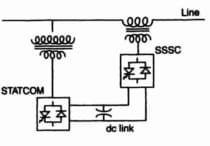 |
| HVDC/HVE |
1. Electrical field intensity of a hemispherical electrode at its surface (radius = r) is proportional to______.
a. 1r
b. 21r
c. 31r
d. r
2. Resistance of a hemispherical electrode of r = 1 m in a soil of r = 100 W-m is in ohms______.
a. 50p
b. 5p
c. 100p
d. 10p
3. 7. If the electrodes are immersed in a trench filled with coke or bentonite, the electrode resistance_______.
a. does not change
b. increases
c. reduces
d. becomes zero
4. If a spherical electrode of r = 1 m is buried at a depth of 2 m, the electric field due to current is maximum at a distance along the surface from the electrode______.
a. 1m2
b. 2 m
c. 21m2
d.1m2
5. The efficiency of shore electrode in comparison with land electrode, with soil r = 1000 W-m and seawater r = 0.2 W-m with sector a = 0.1 radians.
a. 1.0
b. 0.5
c. 0.76
d. 0.95
6. The resistance of good ground return excluding electrodes is taken as_________.
a. negligible
b. 1 W
c. 10 W
d. 100 W
7. Corrosion of buried metal objects occur due to ground return of a DC line only when the object acts as________.
a. cathode
b. cathode under moist condition
c. when not painted
d. Anode
8. Annoying body currents due to grounding of DC lines is about________.
a. 15 mA
b. 1 mA
c. 5 mA
d. 0.5 mA
9. The voltage rise of the earth electrode w.r.t remote earth depends on________.
a. 15 mA
b. 1 mA
c. 5 mA
d. 0.5 mA
10. The voltage rise of the earth electrode w.r.t remote earth depends on_________.
a. resistivity of the soil
b. heat conductivity of the soil
c. temperature rise of the soil
d. all three (a), (b) and (c)
11. The earth electrode in the ground return DC line is located from the converter station at a distance of_______.
a. 1 km
b. 3 to 5 km
c. 10 km
d. 8 to 20 km
12. The design of land electrode connected to the earth electrode depends on______.
a. current and operating time
b. heat dissipation and safety
c. current, operating time, lifetime, polarity, and safety
d. soil resistivity, thermal conductivity, safety, reliability, and electrode current
13. Which of the following soils have low resistivity?
a. rock
b. sandy soil with loam
c. soil with granite layer
d. none of the above
14. As per IEEE standards, human body resistance is taken as________.
a. 500 to 5000 W
b. 5000 to 10,000 W
c. less than 500 W
d. 10 kW to 50 kW
15. The most frequent type of fault in DC systems is______.
a. converter internal fault
b. DC line fault
c. commutation failure
d. arc back and arc through
16. Usual time taken for fault clearing after the fault is sensed is________.
a. less than 2 ms
b. 10 ms
c. 1 to 2 s
d. 100 ms
17. Converter faults are cleared by_________.
a. tripping of AC side CBS
b. blocking the rectifier and inverter
c. opening the ground or neutral CB
d. using backup protection schemes
18. In the worst case, for a phase-to-phase short circuit at nonconducting valve terminals, the peak short circuit current is________.
a. 2Ido
b. 3Is
c. Ido + 3Is
d. 12 (Ido + 3Is)
19. Bypass valve is mainly used to clear________.
a. temporary faults that occur is valve bridges
b. pole-to-pole fault at converter terminals
c. arc back and arc through in valves
d. faults on DC side of the converters
20. Fault sensing is done by comparing_________.
a. Vd and Id
b. dvdt-
c. and dv dIdt dt which set up travelling waves
d. none of the above





0 Comments
If you have any doubt, feel free to ask.